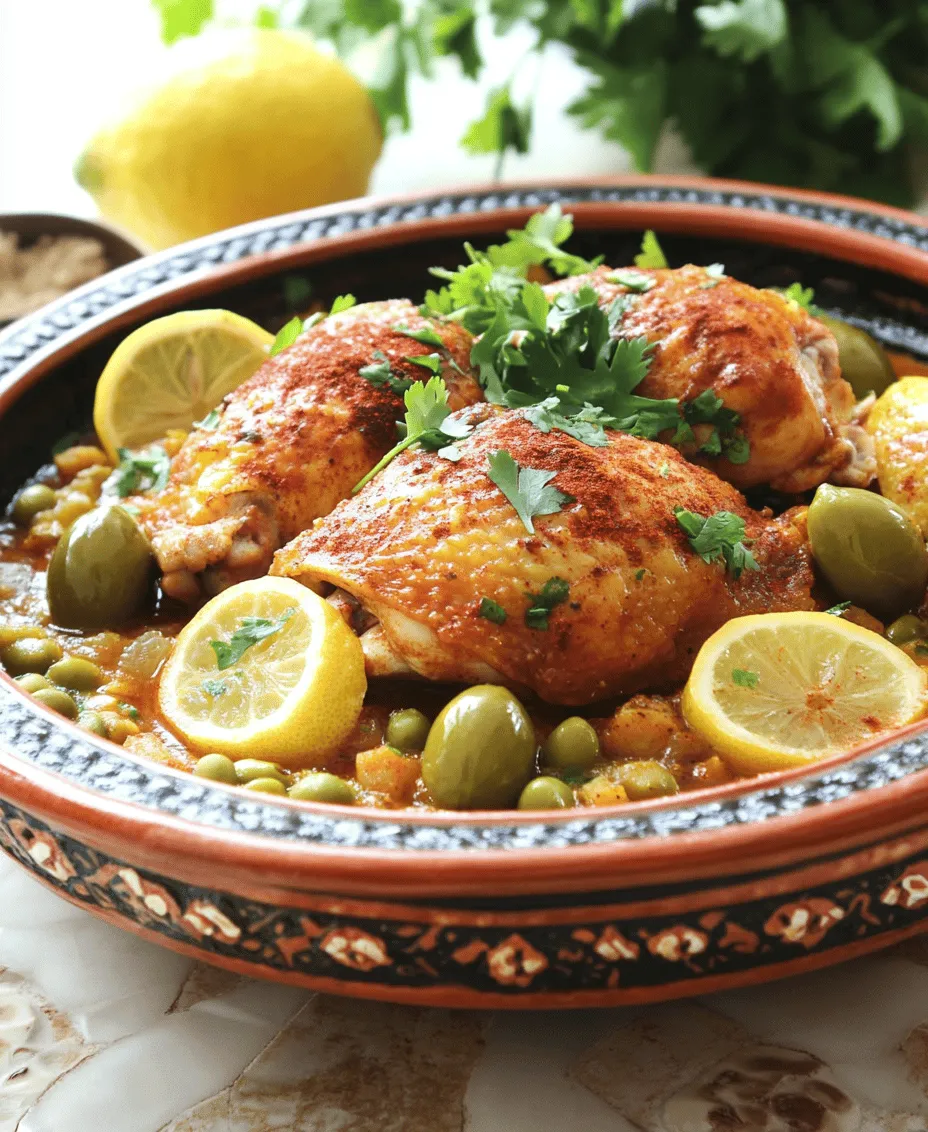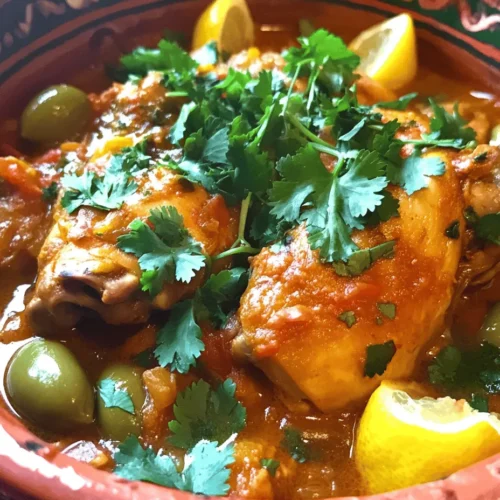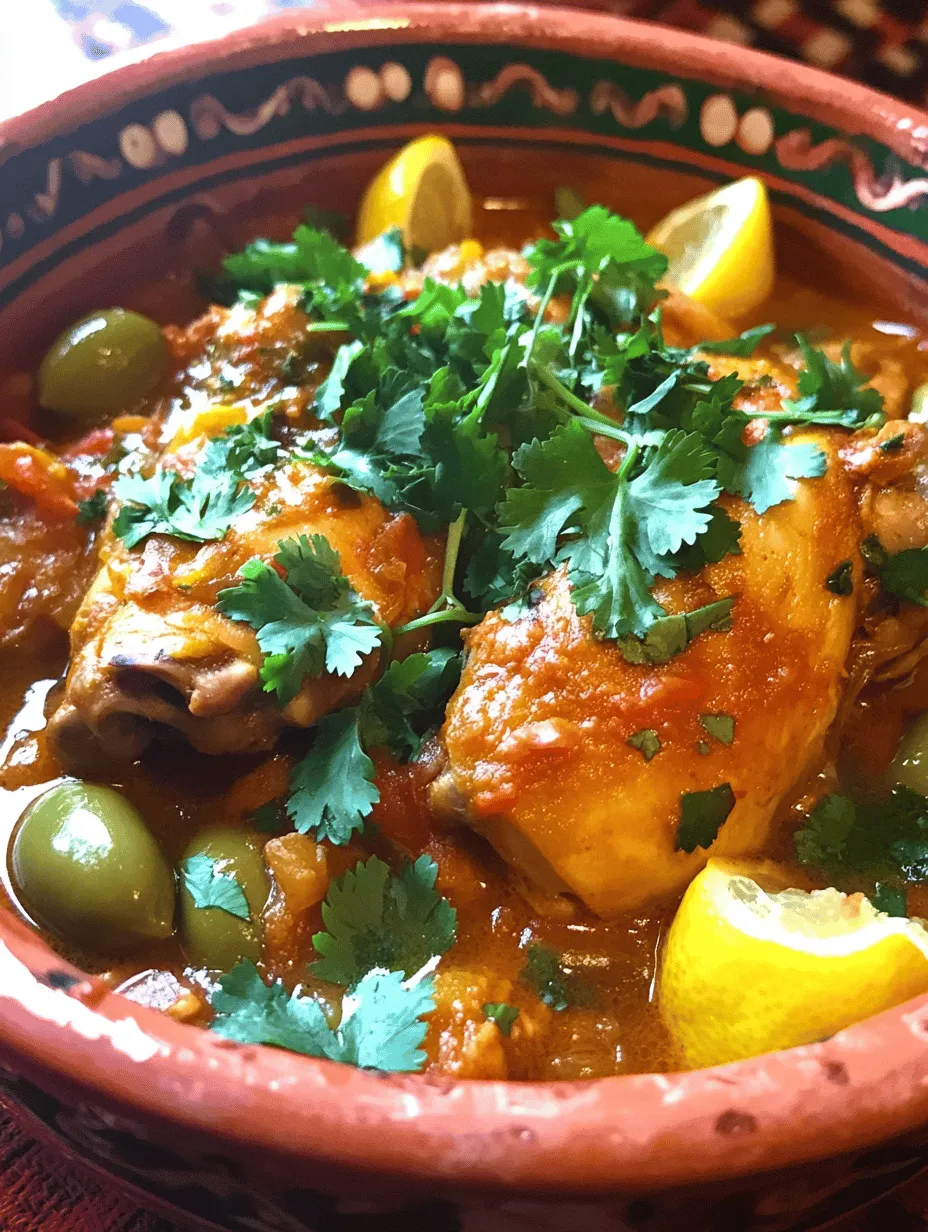Introduction
Discover the vibrant flavors of Morocco with this exquisite Moroccan Chicken Tagine recipe featuring olives and lemons. This dish not only showcases the rich culinary traditions of North Africa but also brings a delightful blend of spices and ingredients that tantalize the taste buds. With its aromatic spices, succulent chicken, and the unique tang of preserved lemons, Moroccan Chicken Tagine is a dish that embodies warmth and hospitality, often served during family gatherings and special occasions. In this article, we will delve into the origins of tagine cooking, the significance of each ingredient, and the step-by-step instructions to create this heartwarming meal at home.
The Essence of Moroccan Cuisine
To appreciate Moroccan Chicken Tagine fully, it is essential to understand the cultural and historical context of Moroccan food. Moroccan cuisine is a melting pot of Berber, Arab, Andalusian, and Mediterranean influences, resulting in an eclectic mix of flavors, textures, and cooking techniques. The country’s geography, with its mountains, deserts, and coastal areas, provides a variety of ingredients that form the backbone of its culinary identity.
Understanding the Cultural and Historical Context of Moroccan Food
Moroccan food tells the story of its history. The spice trade brought many exotic flavors to the region, and ingredients such as saffron, cumin, and cinnamon became staples in Moroccan cooking. The Berber people, indigenous to North Africa, have their own traditional dishes, using locally sourced ingredients prepared in simple yet flavorful ways. The arrival of Arabs and Andalusians during various periods enriched the cuisine further, introducing new techniques and ingredients, such as rice and dried fruits, which are now integral to many Moroccan dishes.
The Importance of Spices and Aromatics in Moroccan Cooking
Spices are at the heart of Moroccan cuisine, transforming humble ingredients into extraordinary dishes. Cumin, coriander, ginger, and cinnamon are commonly used, each adding depth and complexity to the food. These spices not only enhance flavor but also offer various health benefits, including anti-inflammatory properties and digestion support. The use of fresh herbs, such as cilantro and parsley, further elevates the dishes, contributing freshness and brightness to rich, slow-cooked meals.
Traditional Cooking Methods: Tagine Pots and Their Significance
The tagine itself, a conical clay pot, is synonymous with Moroccan cooking. Its unique shape allows steam to circulate, keeping the food moist and tender while allowing the spices to infuse deeply. Cooking in a tagine is not merely a method; it is a cultural experience, often shared among families and friends. The slow-cooking process of a tagine allows flavors to meld together beautifully, resulting in dishes that are rich and aromatic. Whether used on the stovetop or in an oven, the tagine is a testament to the time-honored cooking traditions of Morocco, making it an essential tool in any kitchen aiming to recreate authentic Moroccan flavors.
Understanding the Ingredients
Now that we have explored the essence of Moroccan cuisine, let’s dive into the key ingredients used in Moroccan Chicken Tagine with Olives and Lemons. Each component plays a significant role in crafting the dish’s unique flavor profile and texture.
The Role of Chicken Thighs
When it comes to selecting chicken for tagine, bone-in, skin-on chicken thighs are preferred. This cut of meat is not only more flavorful than chicken breasts, but the bones also contribute richness to the dish as it cooks. The skin helps to keep the meat moist during the slow cooking process, ensuring tender, juicy results. From a nutritional standpoint, chicken thighs provide essential proteins and nutrients, making them an excellent choice for a hearty meal.
The Impact of Spices
The spices used in Moroccan Chicken Tagine are integral to its authenticity and depth of flavor. Key spices include:
– Ground Ginger: Adds warmth and a slight sweetness to the dish, complementing the other spices beautifully.
– Cumin: Known for its earthy flavor, cumin enhances the overall taste of the tagine, providing a warm base note.
– Cinnamon: Often associated with sweet dishes, cinnamon in savory preparations adds complexity and a hint of sweetness.
– Turmeric: This vibrant yellow spice not only adds color but also offers a subtle earthiness that balances the dish.
– Paprika: Provides a mild heat and sweetness, enhancing the overall flavor profile.
Each spice contributes to the layered flavors that are characteristic of Moroccan cuisine, creating a dish that is both fragrant and satisfying.
The Importance of Preserved Lemons
One of the standout ingredients in Moroccan Chicken Tagine is preserved lemons. These are whole lemons that have been pickled in salt and their own juices, resulting in a soft texture and a unique, tangy flavor. Preserved lemons add a burst of brightness to the dish, cutting through the richness of the chicken and spices. They offer a fascinating complexity, transforming the simplest of dishes into something extraordinary. When using preserved lemons, it’s typically the rind that is utilized, imparting a deep lemony essence without the sharp acidity of fresh lemons.
The Significance of Olives
Olives are another crucial component of this dish, often added towards the end of cooking. In Moroccan cuisine, various types of olives can be used, including green olives, black olives, and kalamata olives. Their briny flavor provides a perfect counterbalance to the richness of the chicken and the depth of the spices. Olives also add a delightful texture and enhance the overall visual appeal of the dish, making it not only delicious but beautiful when served.
Step-by-Step Instructions for Moroccan Chicken Tagine
Now that we are familiar with the ingredients and their significance, let’s proceed with the step-by-step instructions for preparing this flavorful Moroccan Chicken Tagine. The following guide will walk you through the initial stages of creating this dish, emphasizing the importance of each step.
Searing the Chicken
The first step in preparing Moroccan Chicken Tagine is to sear the chicken. This process is crucial for flavor development, as browning the chicken creates a rich, caramelized exterior that enhances the overall taste of the dish.
1. Preheat Your Cooking Vessel: Whether you are using a tagine pot or a Dutch oven, begin by heating it over medium-high heat. Allow the pot to become hot before adding any ingredients.
2. Add Oil: Pour in a couple of tablespoons of olive oil or vegetable oil. Swirl the oil around to coat the bottom of the pot evenly.
3. Sear the Chicken: Once the oil is shimmering, carefully place the chicken thighs skin-side down in the pot. Avoid overcrowding; if necessary, work in batches to ensure even browning. Allow the chicken to cook undisturbed for about 5-7 minutes, or until the skin is golden brown and crisp.
4. Flip and Brown the Other Side: Once the first side is golden, flip the chicken thighs over and cook for an additional 5 minutes. This step not only adds flavor but also helps to lock in the juices, ensuring moist and tender chicken.
5. Remove and Set Aside: Once both sides are browned, remove the chicken from the pot and set it aside on a plate. This step allows you to build layers of flavor in the same pot without washing it out.
6. Deglaze the Pot: After searing, you may notice browned bits stuck to the bottom of the pot. These bits are packed with flavor. To deglaze, add a small amount of chicken broth or water to the pot and use a wooden spoon to scrape up the caramelized bits. This will enrich the base of your tagine.
By following these initial steps carefully, you will set the foundation for a deeply flavorful Moroccan Chicken Tagine that is sure to impress. The combination of searing the chicken and deglazing the pot creates a robust base for the spices and other ingredients to shine, leading to a dish that is both delicious and aromatic.
As we continue with the recipe, we will incorporate the spices, vegetables, and other vital components to complete this culinary journey, bringing the essence of Moroccan cuisine into your home. Stay tuned for the next part, where we’ll explore further steps and tips to perfect this delightful dish.

Sautéing Aromatics
The foundation of any great dish begins with aromatics, and Moroccan Chicken Tagine is no exception. The combination of onions and garlic serves as the heartbeat of this recipe, providing depth of flavor that enhances every other ingredient. Start by heating a generous amount of olive oil in your tagine or Dutch oven over medium heat. Add the chopped onions and sauté them until they become translucent, stirring occasionally for about 5-7 minutes. This process is crucial; it allows the natural sugars in the onions to caramelize slightly, which adds a rich sweetness to the dish.
Next, introduce the minced garlic to the pot. Garlic is potent and can burn quickly, so add it just after the onions have softened. Sauté the garlic for an additional 1-2 minutes until fragrant, being careful not to let it brown too much, as this can introduce bitterness. The combination of sautéed onions and garlic creates a fragrant base that sets the stage for the vibrant spices to come.
Incorporating Spices
With the aromatics established, it’s time to awaken the spices that are quintessential to Moroccan cuisine. This is where the art of blooming spices comes into play. Sprinkle in the ground cumin, coriander, cinnamon, and turmeric, stirring them into the onion and garlic mixture. Allow the spices to toast for about 1-2 minutes, stirring continuously. This process releases their essential oils, intensifying their flavors and aromatic qualities.
The fragrant base you’ve created is now ready to support the main ingredients. By blooming the spices, you not only enhance their flavor but also ensure that they permeate the chicken and vegetables, resulting in a cohesive and flavorful dish. This critical step transforms your tagine into a rich tapestry of Moroccan flavors, making every bite a delightful experience.
Deglazing the Pot
Once your spices are beautifully fragrant, it’s time to deglaze the pot. This step is essential for incorporating all the flavorful bits stuck to the bottom of your cooking vessel, known as fond. Pour in a small amount of chicken broth or white wine, scraping the bottom with a wooden spoon to lift those crispy, caramelized bits. This not only adds depth to your tagine but also enhances the overall flavor profile.
Allow the liquid to simmer for a minute, letting it reduce slightly and infuse into the mixture. This step is particularly important as it creates a harmonious blend of flavors, ensuring that nothing is wasted. As the liquid evaporates, the base becomes rich and flavorful, setting the perfect stage for the chicken to join the party.
Simmering the Tagine
Now that your base is ready, it’s time to add the chicken pieces. Arrange them in a single layer in the pot, allowing them to sear slightly in the aromatic mixture. This will help lock in the juices and flavor. After a few minutes, turn the chicken to ensure all sides are coated with the aromatic goodness.
Once the chicken is browned, add the remaining chicken broth along with the preserved lemons and olives. Bring the mixture to a gentle boil, then reduce the heat to low, covering the tagine with its lid. The secret to tender chicken lies in maintaining the right simmering temperature. A low and slow approach allows the chicken to cook through evenly while absorbing all the delicious flavors from the spices and broth.
Let your tagine simmer for about 45 minutes to an hour, depending on the size of your chicken pieces. The magic of time works wonders here, allowing the flavors to meld while the chicken becomes tender and succulent. Check occasionally to ensure it doesn’t dry out; if needed, add a bit more broth to keep it moist.
Finishing Touches and Garnishing
As your tagine nears completion, it’s time to check for seasoning. Taste the broth and adjust the salt and pepper as needed. This is a personal touch that can make a world of difference, enhancing the overall flavor. Once satisfied, it’s time to add the finishing touches.
To elevate the visual appeal of your dish and add freshness, garnish with a handful of chopped fresh cilantro or parsley before serving. Not only does this add a pop of color, but fresh herbs also contribute a vibrant flavor that complements the richness of the tagine.
Serving Suggestions
Moroccan Chicken Tagine with Olives and Lemons is best served with traditional sides that can soak up the aromatic sauce. Couscous is a classic accompaniment; its fluffy texture perfectly absorbs the flavors of the tagine. Prepare the couscous according to package instructions, fluffing it with a fork before serving.
Alternatively, serve your tagine with warm, crusty bread. This allows you to scoop up the delicious sauce and enjoy every last bite. A simple green salad dressed with lemon vinaigrette can also add a refreshing contrast to the rich flavors of the dish.
Health Benefits of Moroccan Chicken Tagine
Moroccan Chicken Tagine is not only a feast for the senses but also offers a range of health benefits. The main ingredients, such as chicken, olives, and spices, provide a balanced source of nutrients. Chicken is a great source of lean protein, which is essential for muscle growth and repair.
Olives are rich in healthy monounsaturated fats, which support heart health. They are also packed with antioxidants that help combat inflammation. The spices used in this tagine—like turmeric and cumin—are known for their anti-inflammatory properties and digestive benefits. Incorporating a spice-rich diet can lead to improved overall health, making this dish not just delicious but nourishing as well.
Cultural Significance of Tagine Cooking
The tagine dish holds a special place in Moroccan culture, representing hospitality and communal dining. Traditionally, it is often prepared for family gatherings or special occasions, symbolizing togetherness and sharing. The slow-cooked nature of tagine encourages diners to savor the meal, promoting conversation and connection among family and friends.
In Moroccan households, the tagine is more than just a cooking vessel; it is a centerpiece that brings people together. The communal aspect of sharing a meal from a single pot fosters a sense of community and belonging, making the experience of enjoying a tagine truly unique.
Conclusion
Moroccan Chicken Tagine with Olives and Lemons is more than just a recipe; it is a celebration of culture, flavor, and tradition that can be enjoyed in the comfort of your home. By following this detailed guide, you can recreate a dish that embodies the essence of Moroccan cuisine, bringing warmth and joy to your dining table. Whether you are a culinary novice or an experienced cook, this tagine is sure to impress and delight, inviting you to explore the rich culinary heritage of Morocco. So gather your ingredients, embrace the cooking process, and enjoy the delightful journey of preparing this iconic dish.



